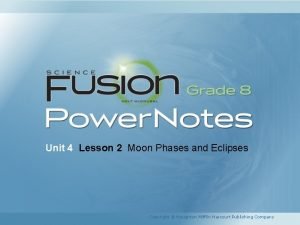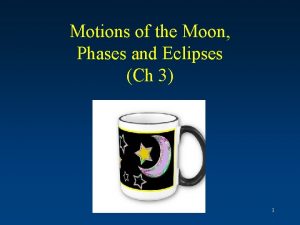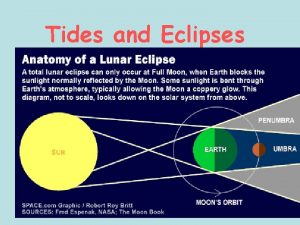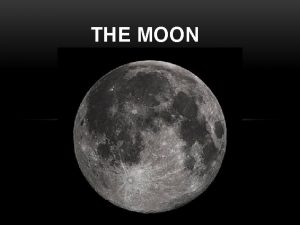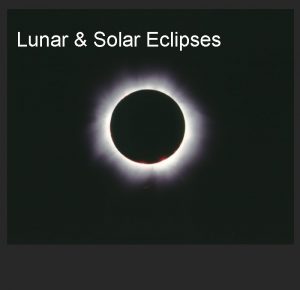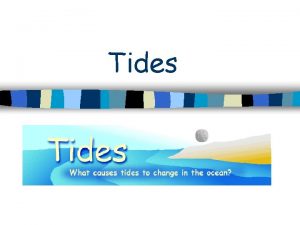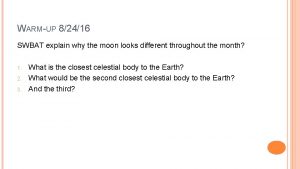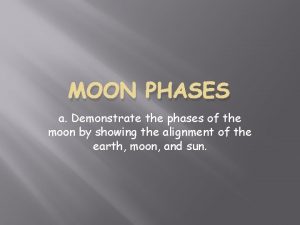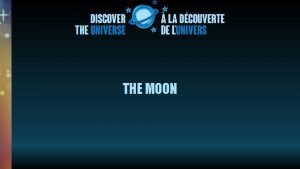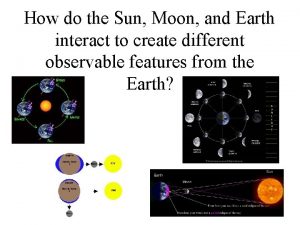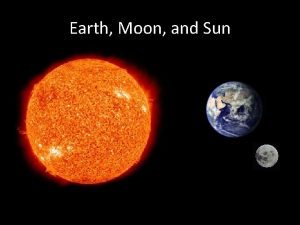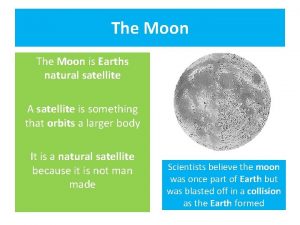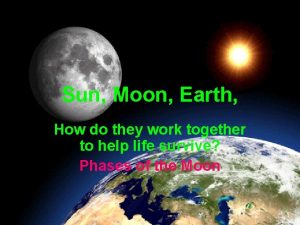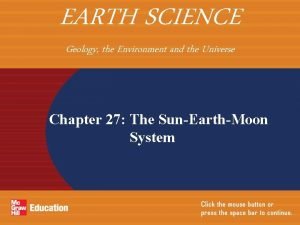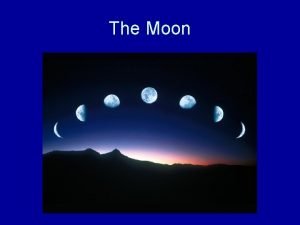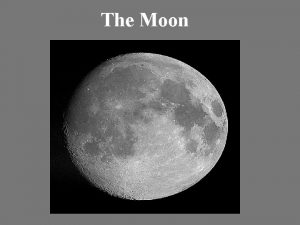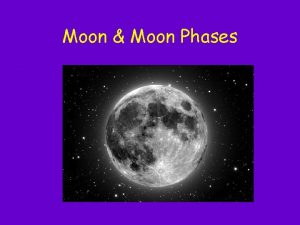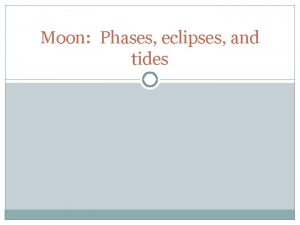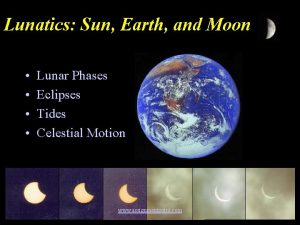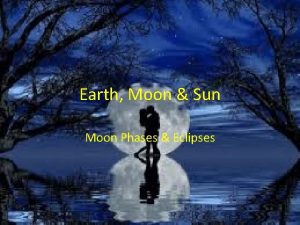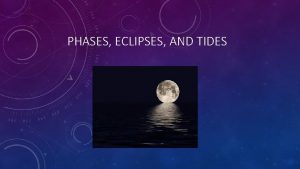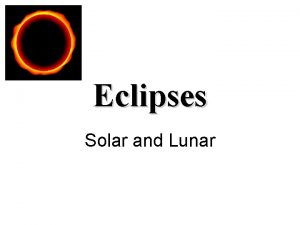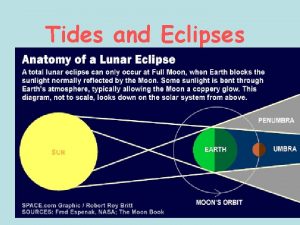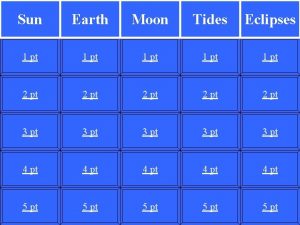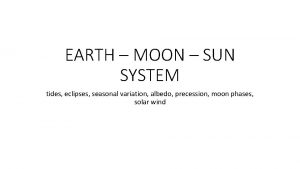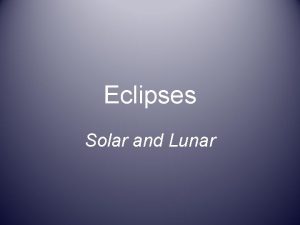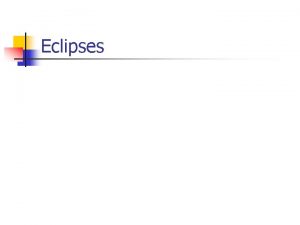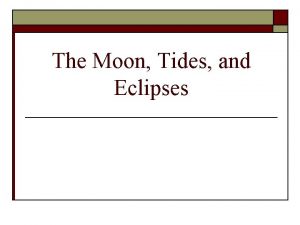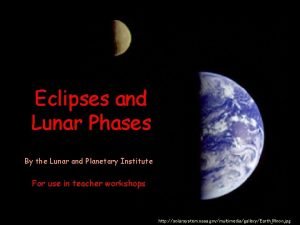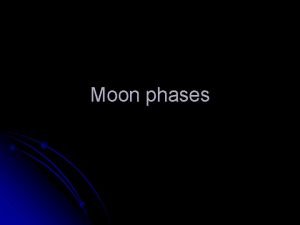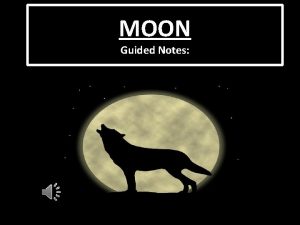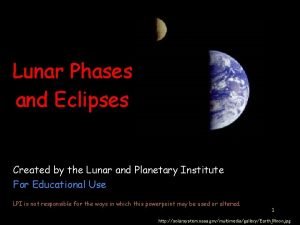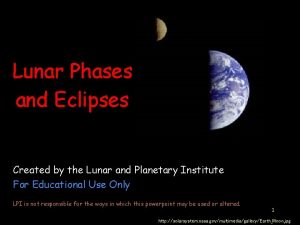Sun Earth and Moon Lunar Phases Eclipses Tides























- Slides: 23

Sun, Earth, and Moon • • Lunar Phases Eclipses Tides Celestial Motion

Phases of the Moon The appearance or shape of the Moon gradually changes through the course of a month. This cycle - the cycle of lunar phases, may be explained if we state the following: 1. The Moon is spherical in shape. 2. The Moon is not self-luminous, but rather reflects the light of the distant Sun. 3. The Moon circles the Earth once per month.


Fun Facts for Lunatics • Lunar Libration: The spin of the Moon proceeds at a uniform rate while the orbit is at a slightly nonuniform rate. The spin can get a little bit ahead or behind the orbit. Hence the face of the Moon presented to the Earth rocks back and forth by some 6° each month, a phenomenon known as longitudinal libration. • The Moon's orbital plane: The plane of the Moon's orbit is tilted by 5° with respect to that of the Earth's orbit. Hence the rotation axis of the Earth is tilted with respect to the Moon's orbital plane by an amount within 5° of 23. 5°, depending on whether the two tilts are in or out of phase. The length of time between moonrise and moonset for, say, a full Moon varies with the season as well. (Also, note the phasing between the two tilts varies continually with time, going full circle every 18. 6 years. ) • The variable speed of the Moon: Like the Earth, the Moon moves in a slightly elliptical orbit as well. Hence, while the average time elapsed from, say, New Moon to First Quarter is 7. 4 days, the actual time can be as short as 6. 7 days near perigee (closest approach to Earth) or as long as 8. 1 days near apogee.

Moon at Perigee and Apogee Distance: 359, 861 km Distance: 405, 948 km

Eclipses • Celestial bodies are always “eclipsing” or moving in front of each other. • Eclipses occur at predictable intervals. • Other names include: Transits and Occultations. • Solar Eclipses can be total, partial, or annular



Moon's shadow on Earth taken by French cosmonaut Jean-Pierre Haigneré aboard the Mir







ECLIPSE QUOTES "Here lie the bodies of Ho and Hi, Whose fate, though sad, is risible; Being slain because they could not spy Th' eclipse which was invisible. " Author unknown: Said to refer to the Chinese eclipse of 2136 BC or 2159 BC. "On the day of the new moon, in the month of Hiyar, the Sun was put to shame, and went down in the daytime, with Mars in attendance. " One of the earliest written records of an eclipse of the Sun, on 3 May 1375 BC, found in the city of Ugarit in Mesopotamia. (Reprinted, from Chasing the Shadow, copyright 1994 by Joel K Harris and Richard L Talcott, by permission of Kalmbach Publishing Co. "If the Sun at its rising is like a crescent and wears a crown like the Moon: the king wll capture his enemy's land; evil will leave the land, and (the land) will experience good. . . " Refers to a solar eclipse of 27 May 669 BC. Rasil the older, Babylonian scribe to the king. Quoted in Historical Eclipses and Earth's Rotation, by F Richard Stephenson, Cambridge University Press, 1997, page 125. "Nothing can be surprising any more or impossible or miraculous, now that Zeus, father of the Olympians has made night out of noonday, hiding the bright sunlight, and. . . fear has come upon mankind. After this, men can believe anything, expect anything. Don't any of you be surprised in future if land beasts change places with dolphins and go to live in their salty pastures, and get to like the sounding waves of the sea more than the land, while the dolphins prefer the mountains. " May refer to a total solar eclipse of 6 April 648 BC. Archilochus, Greek poet (c 680 -640 BC) Quoted in Historical Eclipses and Earth's Rotation, by F Richard Stephenson, Cambridge University Press, 1997, page 338. Partly quoted in Encyclopaedia Britannica CD 98.


1882 Transit (USNO)

Application to Exo Planet Studies HD 209458 (mv = +7. 7) in Pegasus


When the moon is new or full, the gravitational forces of the sun and moon are pulling at the same side of the earth. (See the diagram below. ) This occurrence creates the extra large "spring" tides. When the moon is at first and third quarter, the gravitational forces of the sun and moon are pulling at 90 degrees from each other. (see the diagram below. ) This occurrence yeilds little net tides called neap tides.

More Fun Tidal Tales…. Every few years people that measure such things (chronologists? ) need to add a leap second to the year. The Earth's rotation is decelerating at a rate of about 0. 002 seconds per day per century. The Earth will eventually stop slowing down – when it’s rotation is equal to the moon’s orbital period !!! The Proxigean Tide occurs when the Moon is at its closest point in its orbit to the Earth and in its New or Full Moon phase. At this time, its tidal effect on the Earth is maximum. The times when this will happen often coincide with major coastal flooding events. Between 1997 and 2020 there will be 102 times when this will happen. The moon shows the same face to the Earth because it was deformed by Earth’s gravity when it was still molten. Earth uses this “memory” to grab the moon and slow its spin rate down. WHY ?

Resources Paper Plate Astronomy Solar Events Eclipses Earth Moon Viewer Lunar Posn Calculator Lunar Phases, etc. http: //analyzer. depaul. edu/paperplate/ http: //solarevents. org http: //sunearth. gsfc. nasa. gov/eclipse. html http: //www. fourmilab. ch/earthview/vplanet. html http: //www. fourmilab. ch/earthview/pacalc. html http: //www. lkwdpl. org/schools/elempath/heavenlymotion/
 Lesson 2 moon phases and eclipses answer key
Lesson 2 moon phases and eclipses answer key Facts about first quarter moon
Facts about first quarter moon Lunar eclipse moon phase
Lunar eclipse moon phase What type of tide occurs at a lunar and solar eclipse?
What type of tide occurs at a lunar and solar eclipse? The sun-earth-moon system worksheet answers lesson 1
The sun-earth-moon system worksheet answers lesson 1 Eclipses and tides lesson 3
Eclipses and tides lesson 3 Home.hiwaay.net/ krcool/astro/moon/moon tides/
Home.hiwaay.net/ krcool/astro/moon/moon tides/ Moons pattern
Moons pattern Tim lunar dan solar exo
Tim lunar dan solar exo Compare and contrast spring and neap tides.
Compare and contrast spring and neap tides. Periodic rise and fall of sea level
Periodic rise and fall of sea level Moon phases of the sun is on the right
Moon phases of the sun is on the right Moon phases when the sun is on the left
Moon phases when the sun is on the left When the sun passes between the moon and earth
When the sun passes between the moon and earth How does the earth sun and moon work together
How does the earth sun and moon work together What season is this
What season is this Diagram of earth moon and sun
Diagram of earth moon and sun Whats a natural satellite
Whats a natural satellite Earth sun relationship
Earth sun relationship How does the sun moon and earth work together
How does the sun moon and earth work together Earth moon
Earth moon A person standing in the moon's penumbra will see a
A person standing in the moon's penumbra will see a Whats a natural satellite
Whats a natural satellite How does the sun affect tides
How does the sun affect tides
